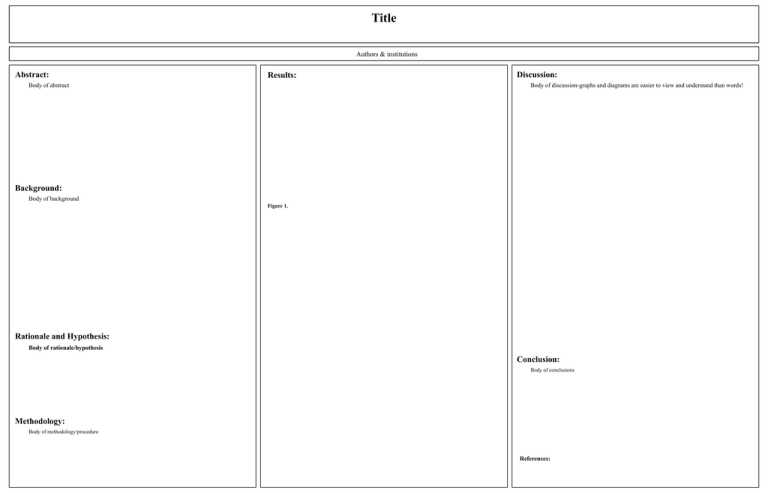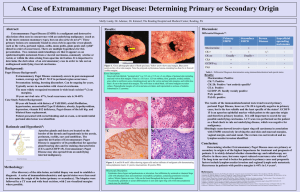Rationale and Hypothesis - American Association of Pathologists
advertisement

Title Authors & institutions Abstract: Discussion: Results: Body of abstract Body of discussion-graphs and diagrams are easier to view and understand than words! A B Background: Body of background Figure 1. Rationale and Hypothesis: Body of rationale/hypothesis Conclusion: Body of conclusions Methodology: Body of methodology/procedure References: A Pathologists’ Assistant’s Gross Description Expedites the Diagnosis of an Uncommon Benign Multicystic Tumor in the Adult Kidney: A Case Report and Review of the Literature Steven Suvalsky MHS, PA(ASCP)* and Larry Anderson M.D.** Iowa Health-Des Moines* and Iowa Pathology Associates**, Des Moines, IA 50309 Abstract: The Pathologists’ Assistant’s (PA’s) gross descriptions are essential to the pathologist for the differential diagnoses of both benign and malignant tumors. For example, concise, gross descriptions are extremely important in multicystic renal tumors in adults. When the PA recognizes and describes specific tumor features in these cases, the pathologist can diagnose both intraoperative and final reports more efficiently. Descriptive names for encapsulated multicystic renal tumors arise from a spectrum of histologic findings and numerous theories of pathogenesis. The Multicystic Nephroma or Multilocular Cystic Nephroma described in this case report is one such uncommon, but specific benign tumor that can present at any age and is recognized by gross appearances. Histologic examination of this Multicystic Nephroma was identical to the microscopic features cited in the literature reviewed. This benign tumor was expected as the gross description suggested and followed microscopic verification from the sections selected by the PA. Discussion: Results: A The gross description of the left nephrectomy by the PA noted a well delineated multiloculated cystic mass and preserved normal parenchyma. The CT scan reported by the radiologist described an extensively septated cystic renal mass suspicious for a multilocular cystic renal cell carcinoma or a partially cystic dysplastic kidney. B Radiologic Differential on Abdominal CT Scan Benign Multicystic Cystic Partially Cystic dysplastic Nephroma differentiated kidney nephroblastoma (CPDN) Background: The pathologists’ assistant (PA) is an intensively trained allied health professional who provides anatomic pathology services under the direct supervision of a pathologist (1). Valuable experience occurs on a daily basis both on the surgical pathology bench and in the autopsy room. Gross examination and feed-back of the final diagnoses between the PA and attending pathologist create a valuable partnership of gross recognition and microscopic verifications. When gross descriptive communication and microscopic verification are utilized, time-consuming dictations and voluminous sections can be avoided. The utilization of pathologists’ assistants in histopathology has been shown to expedite diagnoses and ultimately enhance patient care (2). The case is a 64 year old caucasian male who was hospitalized for lower extremity claudication. His past medical history was generalized arteriosclerotic heart disease and peripheral vascular disease. A 12 cm. solitary cystic mass on an abdominal CT scan was found in the mid portion of his left kidney during workup. A left nephrectomy followed with histopathologic examination of the mass (Fig 1-3). The gross appearance of the solitary and multiloculated cystic mass was unlike that of a multiloculated renal cell carcinoma or a diffuse process such as polycystic kidney (PKD) disease. The diagnosis was a Multicystic Nephroma, a benign cystic tumor of the left kidney. There was no additional tumor treatment required following the nephrectomy. Figure 1. Photomacrographs of the left kidney. (L/R). A. Perinephric fat margins with multifocal loculations and a dilated pelvis. B. The cut surface of the kidney demonstrating a solitary (13 cm.) multiloculated cystic mass. Note the normal, preserved parenchyma in the lower lateral portions including the lower pole (white arrows) and the dilated pelvis (red arrows). Gross Description: “labeled left kidney is an 18 cm. in maximum dimension portion of fat (perinephric) without adrenal tissue or nodules. There is a 15 X 14 X 9 cm. distorted kidney within this fat. An area of multiloculated and well delineated distended kidney spans 13 cm. in maximum dimension including distention of the pelvis suggestive of hydronephrosis. The loculations are smooth with clear colorless fluid to gelatinous material contents. The remaining kidney is unremarkable with smooth cortices and slightly blunted papillary tips. The corticomedullary junctions are well delineated. The ureter is thick-walled. The pelvoureteral junction is patent with a 1 mm. in diameter probe. There are no mass lesions or excrescences in the pelvis or ureter. The vascular margins are unremarkable.” Microscopic log: A1. Vascular and ureteral margins. A2-4. Selected multiloculated area. A5. Normal, preserved kidney. Multilocular Cystic Renal Tumors Multicystic Nephroma CPDN Solitary well-circumscribed multiseptated 3-13 cm. (ave. 6.7 cm.) Most commonly in the lower pole Absence of hemorrhage or necrosis Secondary obstructions of the pelvis & ureter (herniations) Mortality is related only to single function kidney Common ages: males< 4 yrs. , Females > 30 yrs. Histologically distinct Histologically distinct (Septae without embryonal elements) (Septae with blastemal & embryonal elements) ? Biologically different? The pathologists’ assistant is a highly skilled professional responsible for the gross examination and dissection of histopathologic specimens: This includes measurements, recognition of normal and abnormal features, further dissection and the selection of specific lesions/areas for microscopic examination. Additional examinations by this professional may include specimen photomacrography, review of the patient’s past medical history, review of the clinical consultations and review of laboratory tests and radiologic reports. The multiloculated cystic mass was well delineated without evidence of invasion into adjacent and preserved renal tissue. There was dilatation of the renal pelvis and thickness of the ureter without a ureteral obstruction or mass. A C The gross examination of the left nephrectomy utilized a routine and established procedure as for any specimen received by the PA under the supervision of the pathologist. i.e. margins inked, specimen oriented and measured, photographed, weighed and examined both fresh and following 10% buffered formalin fixation. Multilocular cystic Renal Cell Carcinoma A case report in 1956 by Boggs and Kimmelstiel proposed Multilocular Cystic Nephroma (3). Originally considered a lesion of malignant potential, Joshi and Beckwith later proposed a modification that emphasized a subset based on histology. The Multicystic Nephroma and the CPDN became subsets of the category multilocular cystic renal tumors (3,4). Rationale and Hypothesis: Methodology: Malignant Figure 2. Abdominal CT scan demonstrating a cystic abnormality of the left kidney (arrows). Conclusion: B D Figure 3. Photomicrographs (L to R.) A. H&E 10X of loculations with fibrous stroma. B. H&E 4X of juncture with normal kidney. C. H&E 40X of preserved tubule within a fibrous septa. D. H&E 100X lining of a locule with cuboidal epithelium “hobnail appearance”. Microscopic Description and Summary: H & E stains show that the mass is a multicystic lesion. The cysts are lined by cuboidal epithelium which in some areas are somewhat hobnail. There are no areas of malignancy or atypia. The stroma between the cysts are fibrous. Sections away from the mass show normal renal parenchyma. The diagnosis is a Multicystic Nephroma. Malignancy is not identified. Multicystic renal tumors in adults are one example where concise, gross descriptions by the Pathologists’ Assistant (PA) are extremely important and have shown to expedite the diagnosis when specific gross tumor features are recognized by the PA and conveyed to the pathologist. The benign solitary tumor termed “Multicystic Nephroma” or “Multilocular Cystic Nephroma” is uncommon at any age and may have more aggressive behavior if blastema or embryonal elements are seen microscopically in the fibrous septae of the locules/cyst. Ultrasonography is the preferred non-invasive study for diagnosis and when combined with CT or MRI scans offer more detailed evaluation of the cystic lesion and stromal tissue. Histologic examination of this Multicystic Nephroma in a 64 year-old male was identical to the microscopic features cited in the literature reviewed. References: 1. 2. 3. 4. Official website of the American Association of Pathologists’ Assistants, founded in 1972. http:www.pathologistsassistants.org. Grzybicki D.M., Galvis C.O., & Raab, S.S.: The Usefulness of Pathologists’ Assistants. American Journal of Clinical Pathology, 112:619-626, 1999. Lederman, H.M. and Hurh, P.J.: Multilocular Cystic Nephroma. Emedicine from WebMD, April, 2003. Ordonex, N.G. & Rosai, J.: Rosai and Ackerman’s Surgical Pathology. Ninth Edition., Vol. 1, Chapter 17, pp. 1246-1247. 2004.








